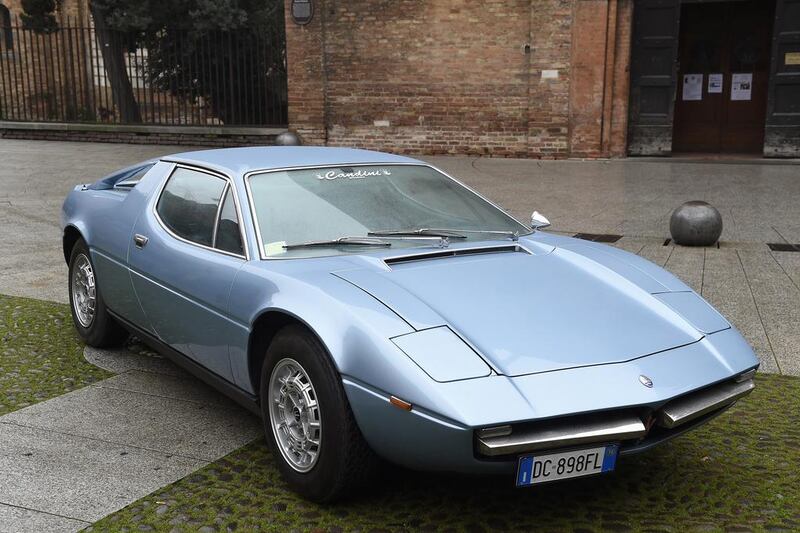Ask motoring journalists why they got into the business in the first place and, chances are, they will tell you something about getting paid to drive the occasional flash motor, seeing the world for free and having an outlet for their creativity. But mostly it will be about doing, for a living, what was their hobby anyway. And it was no different for me, although my initial forays into the world of automotive writing were not about new cars.
New cars always bored me (and many still do) but classic cars were a different matter. The cars I grew up lusting after, the ones I used to have framed photos and posters of on my bedroom walls, the ones I collected brochures of, the ones I would close my eyes and dream of driving, even though I was a decade away from being legally allowed behind their collective steering wheels. They were, and always will be, dream fodder. And, like many classic-car enthusiasts, I have something of a bucket list that I’ve been steadily making my way through over the past few years.
Today I get to cross another off that slimming list: an impossibly beautiful, blue Maserati, of 1972 vintage. The Merak, named after a star in the Ursa Major constellation, was one of my very favourite poster cars. It had everything: pop-up headlamps, a mid-mounted engine, lines that were as distinctive as they were curvaceous and a leather-lined cockpit. It was also possessed of a rarity that only the finest Italian exotica could muster back in the 1970s – in a production life cycle of 11 years, only 1,820 were built.
One of the main issues with classic-car journalism is that you normally have to rely on the generosity and flexibility of owners who, understandably, can get a bit anxious about letting a complete stranger loose in their beloved motors. Yet the owner of this precious Maserati is nowhere to be seen as I pull at its driver’s door latch and swing open the delicate metal closure. Apparently he’s just left us to it while he mingles with the few hardy souls that have gathered in a non-assuming piazza in the middle of Bologna in northern Italy, to celebrate the birth of one of the country’s most illustrious car companies: Maserati.
For it was in a side street, just off this cobbled and grassed square, that the Maserati brothers opened their first workshop, exactly a century ago. The rain is coming down, the sort of fine drizzle that soaks you through in seconds, but there are a good 40-or-so onlookers braving the inclement conditions to pay their respects, look at some of the gathered classic and new models, as well as consume industrial quantities of fine Italian espresso. The atmosphere is one of hushed reverence – no unnecessary revving of engines, no blaring of modified exhausts, just dignified respect for a storied brand that, against the odds, is still here and in ruder health than ever.
The night before, in a moving tribute to the Maserati brothers and the small band of engineers, craftsmen and women, racing drivers and embattled industrialists who ran the company by the seats of their pants, we gathered in the Bologna Chamber of Commerce where the Maserati company was formally registered in 1914. One man in the audience, Ermanno Cozza, has worked for Maserati for 60 of those 100 years and the joy on his face was palpable. He’s seen it all and stuck with it through thick and thin. He’s viewed as a part of the family – a vital link between the past, present and future of Maserati. We heard fascinating anecdotes from Adolfo Orsi, whose family bought the company from the Maserati brothers in 1937 and ran it until the acquisition by the French manufacturer Citroën in 1968. Orsi is one of the world’s most knowledgeable Maserati historians and we could have spent days listening to him recount the glory days, the racing victories and the financial woes that constantly clouded Maserati’s future.
It was the Citroën years that, to my mind, produced the most fascinating and glamorous cars in Maserati’s rich history. By the time of the takeover, the elegant Ghibli was already in production (there are two examples here today) but in 1969 came the sleek, fastback Indy (named after Maserati’s famous victories in 1939 and 1940 at the Indianapolis 500), followed in 1971 by a car many view as the ultimate Maserati road car: the Bora.
For me, though, the Bora-influenced Merak of 1972 was always “the one”, although 1974’s Khamsin has dated remarkably well over the decades, its razor-sharp Bertone-styled profile still managing to cut a futuristic dash, especially as only 430 were ever built over its eight-year life. Between them, these models solidified, in my juvenile mind, what glamorous Italian GT cars should be all about. They were never true competitors to bona fide supercars and they were too rare to ever grow sick of seeing. To even catch sight of a Maserati from the Citroën era, never mind get to drive one, is a pinch-me moment, the likes of which I rarely get to experience.
“Never meet your heroes,” advise classic-car detractors, and they often have a valid point. You’ve spent far too many years drooling over these beautiful objects in magazines and at classic-car shows, so how could the reality ever meet your unreasonable expectations? And, on the face of it, this early Merak could be the biggest disappointment of my career. It’s a well-used, slightly scruffy example that at least appears honest. It’s no prissy trailer queen and that means today could swing either way: it’ll either perform faultlessly because it’s obviously used by its owner, or it could break down catastrophically on a crowded autostrada in this properly miserable weather. I hope, with every fibre of my being, it isn’t the latter.
I open the door and nervously take a seat. First impressions are that the Merak is an ergonomic disaster, with ill-advised dashboard componentry lifted straight from Citroën’s then- new SM. The whole “parts bin” approach to furnishing car interiors was at its peak in the early 1970s and the Merak’s cabin is a mishmash of bits and pieces that Maserati’s engineers probably thought “will do for now”. The Ghibli looks and feels so much more special than this but, to his credit, when Alejandro de Tomaso took over Maserati in 1975, one of the first things he did was give the Merak a more fitting interior.
My spirits remain high – so what if the dashboard is a mess and the trim quality is dubious? So what if a Ferrari 308 GT4 (the Merak’s initial rival from down the road in Maranello) trashed it in the ambience stakes? Just look at the outside of the thing – it’s one of the most beautiful car designs of all time. Giorgetto Giugiaro, at Italdesign, was at the top of his game when he penned the Merak. Virtually identical to the Bora up to the b-pillars, at the rear (to save costs) a simple sheet-metal engine cover was used in place of the Bora’s expansive, rear-hinged glass aperture. But – and this shows the genius of the designer – to prevent the Merak’s rear looking like that of a pickup truck with a vertical rear window and a huge, flat expanse of metal behind it, he incorporated two “flying buttresses” into either side, giving the visual impression of a sleek fastback.
If only as much effort had been put into the Merak’s innards. Sensing the car has been parked up and left in first gear, I search for the clutch pedal with my left foot and realise that the written complaints about Italian car pedals made by contemporary journalists were well founded. The clutch, brake and accelerator pedals are so offset to the right of the box that it’s hilarious. Until, that is, I try to operate them with my feet that are unwisely shod in clumpy boots. Of course, I should be wearing Gucci loafers, not ungainly Timberlands. My fault.
I eventually put it in neutral and nervously twist the ignition key. I say nervously because everything seems so dainty and fragile, like it needs to be treated with respect lest you do some terrible damage. After a couple of turns, the Merak’s 3.0L V6 erupts just millimetres behind my head and I’m disappointed further still. It sounds flat, soulless and devoid of character. How could a car this beautiful sound so ordinary?
Could it be that the naysayers will be proved right? That the Merak experience should have stayed firmly in my fantasies? As the feeble windscreen wipers smear the rainwater instead of clearing it and as the minuscule single-door mirror has steamed up so it’s completely useless, I can’t help but feel defeated. After years driving nothing but brand-new cars, I worry that my emotional attachment to these relics has reached an unhappy end.
But as I edge the Merak out of the piazza, through the sodden and ridiculously narrow Bologna streets and onto the open autostrada, my enthusiasm steadily returns. I catch sight of the Merak’s profile as I drive past a shop window and almost faint, it’s that beautiful. Other drivers sound their horns in appreciation rather than frustration, people young and old stop for a second and watch this classic Maserati brighten this dullest of dull days and the magic of classic Italian cars comes back with more power than ever before.
The pedals continue to cause me problems, with the wide soles of my boots making it virtually impossible to conduct smooth gear changes and braking. When I do apply the brakes, the skinny front Michelins nervously hop about on the wet tarmac and the steering wheel seems to have a life of its own. Once I get onto some sweeping fast roads and open it up, though, the Merak really starts to sing.
Its V6 soundtrack takes on a harder edge once the revs climb and the engine feels strong and urgent, helped by the car’s low 1,300-kilogram weight. At 6,000rpm it hits its redline and all of its 190 horses are being deployed. And yes, I know that sounds a bit pathetic, but it was easily the equal of the Ferrari Dino and Porsche’s 911 when it was designed. My 2.0L Scirocco would run rings around any Merak, out-brake and out-corner it, too, but that’s not the point. This is special – unique – and you adjust your inputs and expectations accordingly.
Over the course of an hour or so, the Merak continues to dig deeper into my heart and, as I hand it over to the next journalist on the waiting list, I can’t help but shoot it one last glance. This is the magic of the Merak for me because what did it for me in the 1970s and 1980s still does it for me today and this car, more than practically any other, will continue to give me sleepless nights for all the right reasons, until the time comes when I either have one of my own or have completely lost my marbles. Perhaps the two events might even go hand-in-hand.
khackett@thenational.ae










